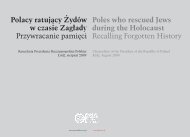Polacy ratujÄ cy Å»ydów w czasie ZagÅady â Przywracanie PamiÄci
Polacy ratujÄ cy Å»ydów w czasie ZagÅady â Przywracanie PamiÄci
Polacy ratujÄ cy Å»ydów w czasie ZagÅady â Przywracanie PamiÄci
Create successful ePaper yourself
Turn your PDF publications into a flip-book with our unique Google optimized e-Paper software.
Rodzice nadali mi dwa imiona – Adam Daniel. Wo∏ano do mnie– AdaÊ. Po ceremonii chrztu zosta∏em zarejestrowany jako DanielCzerwiƒski. Po wielu latach dowiedzia∏em si´, ˝e udzielono mischronienia w klasztorze z woli Metropolity lwowskiego arcybiskupaAndrzeja Szeptyckiego. Zgodnie z poleceniem Metropolity wszystkiegreckokatolickie klasztory – m´skie i ˝eƒskie – udziela∏y w <strong>czasie</strong>wojny pomocy i ukrywa∏y przeÊladowanych w Galicji WschodniejPolaków i ˚ydów. W ten sposób uratowano ˝ycie co najmniej 150osób, g∏ównie dzieci. Kilkoro z nich pozna∏em osobiÊcie.Pewnego dnia, ju˝ po wycofaniu si´ Niemców z Podola – by∏o tolato 1944 r. – zniknà∏ z klasztoru jeden z ch∏opców, ¸ewkoChamiƒski. Spotka∏em go po 50 latach w Newport (stan RhodeIsland). Powróci∏ do rodowego nazwiska – Leon Chameides – zosta∏wybitnym amerykaƒskim pediatrà-kardiochirurgiem. Jego brat, któryrównie˝ ukrywa∏ si´ w klasztorze Studytów, profesor Zwi Barnea,fizyk, zajmuje si´ krystalografià, a zarazem jest Êwiatowej s∏awyuczonym w zakresie nowoczesnych technologii informatycznychna jednym z uniwersytetów w Australii. Kontakt z Leonemnawiàza∏em przypadkowo. RozpoznaliÊmy si´ dzi´ki zdj´ciu.Wykonano je w 1943 r. By∏a to jedyna grupowa fotografia, jakàwszystkie dzieci otrzyma∏y w <strong>czasie</strong> pobytu w klasztorze. Kopi´ tegozdj´cia przekaza∏em w 2005 r. klasztorowi w Uniowie po uroczystoÊciods∏oni´cia mosi´˝nej tablicy, na której napis g∏osi: „W ho∏dzieMetropolicie Andrzejowi Szeptyckiemu i ArchimandrycieKlemensowi Szeptyckiemu – za ratowanie w <strong>czasie</strong> II wojnyÊwiatowej ˝ycia dzieci polskich, ukraiƒskich i ˝ydowskich”. DziÊfotografia ta zawieszona w sali muzealnej Uniowskiej ¸awrydokumentuje dla przysz∏ych pokoleƒ niezwyk∏à rol´, jakà ZakonStudytów odgrywa∏ w <strong>czasie</strong> wojny, udzielajàc schronienia i pomocyludziom bezbronnym i przeÊladowanym. Zdj´cie to widzia∏emrównie˝ w Muzeum Holocaustu w Waszyngtonie – kopi´ przekaza∏features, good, kind eyes. He emanated peacefulness. He was serious, thoughtful, he spoke quietly ina clear way, with good diction. He became my confessor.After arriving in Uniów I saw a dozen other boys in the dorm room. After a time there, I realizedthat three among them were children from Jewish families living in Uniów under assumed names.My parents gave me two names – Adam Daniel. I was called – AdaÊ. After the baptism ceremonyI was registered as Daniel Czerwiƒski. Many years later I found out that I had received shelter at themonastery because of the good will of the Metropolitan of Lwów, the Archbishop Andrzej Szeptycki.Based on the recommendation of this Metropolitan, during the war, all Greek Catholic monasteries andconvents granted assistance and hid Jews and Poles who were being persecuted in those parts of easternGalicia. In this way, they saved the lives of at least 150 people, mostly children. I have met a few of thempersonally.One day, after the Germans had already retreated from Podole – it was the summer of 1944 – oneof the boys from the monastery, ¸ewko Chamiƒski, disappeared. I met him 50 years later in Newport(in the state of Rhode Island). He had returned to his ancestral last name – Leon Chameides, hebecame a distinguished American pediatrician, cardiac surgeon. His brother, professor Zvi Barnea whoalso hid in the Studite monastery, has gained world renown for his studies in the area of newinformation technologies at a university in Australia. I met Leon by accident. We recognized each otherthanks to a photograph taken in 1943. It was the only group photograph which the children had everreceived during their stay at the monastery. I gave a copy of this picture to the monastery in Uniówin 2005, after the unveiling of a plaque on which the brass words read: “In homage to the MetropolitanAndrzej Szeptycki and the Archminandrite Klemens Szeptycki – for saving the lives of Polish,Ukrainian, and Jewish children during World War II.” Today, the photograph hangs in one of therooms of the Uniów monastery to remind future generations of the extraordinary role which the StuditeOrder played during the war, providing shelter and aid to the defenseless and the persecuted. I have alsoseen this photograph at the Holocaust Museum in Washington, D.C., a copy presented to them by LeonChameides. Directly after the war, the role of the Metropolitan Andrzej Szeptycki and the wholebrotherhood of the monastery of the Studite, was described by Kurt Lewin. His book, entitled“I Survived. The Sage of St. Jura written down in the Year 1946” (pub. Zeszyty Literackie,Warszawa 2006), is not only a beautiful literary report of the dangers and bravery, sacrifice and risk,which all the monks took, but it also makes one aware that in order to save one life, often a whole chainof people of good will is needed. On the other hand, one report to the police, Gestapo, or SS bureau was



